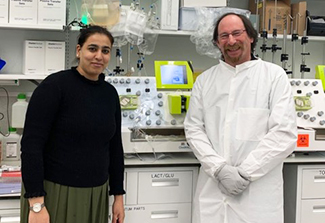NCI program trains foreign scientists in NIH labs
November/ December 2021 | Volume 20 Number 6
 Photo Courtesy of Dr. Gaurav NarulaIndian scientist Dr. Albeena Nisar (left) used her Short-Term Scientist Exchange Program (STSEP) fellowship to collaborate with Larry Moses and others in an NCI lab at NIH.
Photo Courtesy of Dr. Gaurav NarulaIndian scientist Dr. Albeena Nisar (left) used her Short-Term Scientist Exchange Program (STSEP) fellowship to collaborate with Larry Moses and others in an NCI lab at NIH.
To advance cancer research and cultivate global partnerships, the NIH’s National Cancer Institute (NCI) has been providing training to foreign scientists in its Bethesda labs since 2010. The
Short-Term Scientist Exchange Program (STSEP)—managed by NCI’s Center for Global Health—has provided intramural training to 15 scientists from eight different countries. Participants must have a Ph.D. or M.D. and a minimum of one year of postdoctoral experience in cancer research. The training period can be up to six months, although the mentorships often continue for years, noted program officer Dr. Vidya Vedham. “This initiative also provides benefits for NCI intramural researchers, by providing an opportunity to partner with cancer researchers across the globe and expanding the field,” she said.
Targeting cervical cancer in Cameroon
In Cameroon, few women are screened or treated for cervical cancer. Cameroonian gynecologist-obstetrician Dr. Joel Fokom Domgue reached out to NCI because he wanted to improve his knowledge of the human papillomavirus (HPV), which causes cervical cancer. NCI’s Dr. Mark Schiffman, who has done pioneering work in the field of HPV epidemiology and cervical cancer prevention, agreed to mentor Domgue through STSEP.
Supported by Cameroon’s Ministry of Health and the University Teaching Hospital of Yaounde, Domgue worked to adapt technologies for the African context. His accomplishments include a validation study of a lower-cost HPV testing device published in The Journal of Clinical Microbiology. STSEP helped Domgue improve his knowledge of HPV epidemiology and genetics, screening assays and vaccines. He also developed study design, statistical analysis and project management skills. Domgue said it was a “rewarding experience” that helped him advance in his career. Through the relationship, Cameroon also became a participating site for a multi-country NCI project focused on improving the accuracy of visual screening for cervical cancer.
Bringing the latest cancer therapy to India
Mumbai’s Tata Memorial Centre sees up to 500 new cases of pediatric acute lymphocytic leukemia (ALL) each year. When Indian pediatric oncologist Dr. Gaurav Narula discovered NCI had developed a new cell therapy for the disease, he wanted to see if he could replicate it in his country. India’s standard treatment—bone marrow transplantation—was time consuming and costly. The new approach—chimeric antigen receptor (CAR) T-cell therapy—involves removing the patients’ T cells and modifying them in the lab so they will attack cancer cells.
“We knew Western pricing for CAR T-cell therapy would never be affordable in India. We would have to do it ourselves,” said Narula. He combined forces with Dr. Rahul Purwar of the Indian Institute of Technology-Bombay who’d begun studying the new treatment.
Through STSEP, Narula and his team members involved in clinical care, transfusion and lab work visited NCI to learn each step of the process. They have successfully developed India's own version of CAR T-cell therapy, which they are currently evaluating through clinical trials. Equally valuable are the lasting friendships that have been formed with NCI scientists, Narula said. “They may not be easily measurable, but they are what truly, truly matter.”
Advancing genetic sequencing in Mongolia
Mongolia has a higher incidence of liver cancer than anywhere else on the planet. To better understand the causes for that, Mongolian scientist Dr. Enkhjargal Bayarsaikhan spent six months at NIH conducting genomic analyses of liver cancer, working with NCI’s Dr Xin Wei Wang under STSEP. They discovered most instances of liver cancer in Mongolia are the result of infections with different strains of hepatitis and published the results in Nature Communications.
“It was a fantastic time for me,” Bayarsaikhan recalled. “I gained confidence as a researcher and became inspired to work to develop science in my country.” Today, Mongolian patients benefit from targeted therapies based on genetic analysis. Bayarsaikhan is now conducting epidemiological studies to understand how hepatitis mutations interact with chemicals, while mentoring several students who are working toward advanced degrees.
More Information
To view Adobe PDF files,
download current, free accessible plug-ins from Adobe's website.
Related Global Health Research Topics